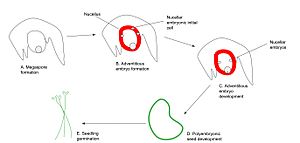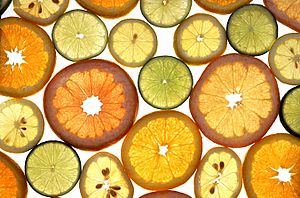Nucellar embryony facts for kids


Nucellar embryony (also called Nu+) is a special way some plants make seeds. It happens in many plants, especially citrus fruits like oranges and lemons. This process is a type of apomixis, which means new embryos (baby plants) grow from the nucellus tissue inside the seed, without needing sexual reproduction or a sperm and egg joining.
When seeds develop in plants that have this ability, the nucellus tissue, which is around the egg sac, can create special cells called initial cells. These cells grow into extra embryos. Because these extra embryos are made without sexual reproduction, they are exactly like the parent plant. They are clones!
Normally, most flowering plants reproduce sexually. This means a sperm cell from pollen joins with an egg cell to make a zygotic embryo. This embryo gets genetic material from both parent plants. But in nucellar embryony, the embryos grow asexually from the nucellus tissue.
Sometimes, a seed can have both a normal zygotic embryo and nucellar embryos. The initial nucellar cells grow and divide. Often, the nucellar embryos grow faster and stronger than the zygotic embryo, making the zygotic embryo stop growing. This leads to a polyembryonic seed, which means it has many baby plants inside (look at Figure 1 to see how this happens). Because nucellar embryos are clones of the mother plant, they are very useful for growing citrus trees that are exactly the same.
Contents
How Nucellar Embryony Works
Nucellar embryony can happen even if the ovule (the part that becomes the seed) is fertilized or not. Instead of using the endosperm (a food source for the embryo in normal seeds), the nucellar embryos get their food from the surrounding nucellus tissue. For example, the ‘Valencia orange’ can develop nucellar embryos whether it's been fertilized or not.
Special Features of Nucellar Embryos
One interesting thing about nucellar embryo development is how their cell walls change. When the initial cells are about to start growing into embryos, their cell walls become thicker. This is probably because a substance called callose is added, which makes the cell less permeable. As these initial cells grow bigger, become rounder, and start dividing, their cell walls become thinner again. This allows the nucleus (the control center of the cell) to be seen more clearly.
Seedless Fruits and the Citrus Industry
Many plants, including citrus fruits, can fertilize themselves. This usually leads to fruits with many seeds, which people often don't want to eat.
Seedless fruits are very popular in the citrus industry. To be seedless, a citrus plant often needs to have a trait called self-incompatibility. This means the plant cannot fertilize itself and produce fertile seeds. This is also linked to parthenocarpy, which is when a fruit develops without any fertilization. Self-incompatible fruits can use parthenocarpy to make seedless fruits.
For example, the ‘Afourer’ mandarin is a type of citrus that can produce seedless fruits if it's not pollinated by another plant. If it is cross-pollinated (meaning pollen from another plant lands on it), farmers can apply a special chemical called gibberellic acid to reduce the number of seeds.
Nucellar embryony is very important for the citrus industry because it helps grow uniform rootstock. Rootstock is the bottom part of a tree that the desired fruit-producing part (scion) is grafted onto. Uniform rootstock helps ensure that all the fruit trees grow similarly and produce consistent fruit. However, this trait can make it harder to create new types of citrus through cross-breeding, because the nucellar seedlings are clones of the mother plant and don't get any traits from the "father" plant.
Images for kids
-
Figure 1. depicts the process of nucellar embryony. A) begins with megaspore formation. B) shows the nucellus and forming of cells, nucellar embryonic initial cells, from the nucellus tissue. These initial cells form, divide, and expand. C) The nucellar embryos are developed. If and when a zygote is present, the nucellar embryos supersede the zygote. D) The presence of extra embryos formed from the nucellar tissue gives rise to polyembryonic seeds. E) Polyembryonic seeds germinate and develop.
-
Most commercial citrus varieties produce mainly nucellar seedlings.
See also
 In Spanish: Embrionía adventicia para niños
In Spanish: Embrionía adventicia para niños



